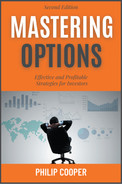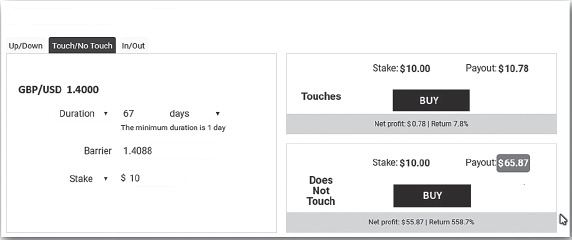There are several different types of options, which have the characteristics that we have outlined in the previous chapter; however, there are some options that have slightly different characteristics and one particular type—the binary option—which is very different from other options. Options are categorized in classes as follows:
• American-Type Option: This term refers to how the option is exercised. An American option can be exercised at any time during the life of the contract. It could be exercised a few days after the contract is opened or at any time before the expiration date. These options are the most used in today’s markets and all the examples of options in this book are American-type options.
• European-Type Option: This option gives the option holder the right to only exercise the option on the specified expiration date. For example, you might have an European option that gives you the right to buy 100 ABC shares on June 15 at $5.00 per share. The price rises between now and May 19 and reaches $10.00 per share, but you cannot exercise your option until June 15. By the time June 15 arrives, the stock is only worth $2.00 per share. Now you will have to let your option expire worthless.
• Barrier Option: This option has a component in addition to the strike price and the expiry date. This component is called a trigger. The trigger or barrier price, if reached, either opens the options contract (knocks in) and makes it a regular options contract or cancels the option contract (knocks out) and the contract is never taken up. These options are cheaper than plain vanilla options, because in many cases, these options never materialize.
• Binary Options: These are very simple to use and trade. The reason they are called binary or digital options is that when you trade them you only have two decisions to make, either a 0 or a 1. It’s a bit like flipping a coin, you can call heads or tails, and there is no other option available to you. This is the same for the binary option; its future price is either going to be up or its going to be down. What could be simpler than that? This is what makes the binary option an excellent and easy way for a novice trader to get into the global trading markets and trade currencies, stocks, commodities, or stock indexes.
The binary option is not always traded in the same way and traders have access to several different methods of trading them. Note here that I have not mentioned investors because binary options are not investment instruments such as vanilla options.
The High/Low method is sometimes called the Up/Down or the Call/ Put method. This is the most basic type of binary options trade. With this trade, you choose an asset, which might be a stock, currency, commodity, or index, and you decide whether the asset will be trading at a price that is higher or lower than the current price at a chosen expiry time. If you believe the answer is higher, you simply pick High on the binary options platform you trade on (or Up or Call). If you believe the answer is lower, you then pick Low on your platform (or Down or Put). Figure 3.1 shows a $10 GBP/USD binary options possible trade. The strike price is 1.4070 with expiry in three hours from now (11:50). If you decide that GBP/USD will go higher, you will click on the purchase button for higher. Some platforms use Call/Put terminology. If GBP/ USD is higher on expiry, you will get an 81.9 percent return on your investment. So you will receive $18.9, which is your initial investment of $10 plus profit of $8.19. If you decided that GBP/USD would be lower after 3 hours, you would click on the purchase button for lower. The return on investment if you won this trade would be 81.7 percent. If you lose a binary options trade, you lose 100 percent of your initial investment. In this case, $10.

Figure 3.1 High/low GBP/USD trade
The expiry times can vary, or they can be set by you on some platforms, which is a more customizable form of High/Low trading offered by some binary options brokers. Expiry times range widely, but for High/Low trades, it will usually range from 5 to 15 minutes to sometime hours later on the same day. However, more and more binary options brokers are offering long-term expiry times ranging from 1 week to 1 month or even 6 months.
The One Touch/No Touch trading method works a little differently than high/low trading. With one touch/no touch trading, you are looking at a given asset, and you are deciding if the asset will reach (one touch) or not reach (no touch) a specific price point by the expiry date.
This price point may be anywhere between the current price and the price on the expiry date. Usually, the further away the price point is from the current price level, the higher your potential payout if you win. A price point that is located nearby is easier to reach, and therefore would pay out less since the risk is lower. If you say that the asset will touch the price point, and it does, anytime within the expiry period, you win your trade and the payout. If you are wrong, you lose your investment. However, you can also decide that the asset will not touch the price point during the duration of the time frame. If you say that the asset will not touch a specific price point, and it doesn’t anytime within the time period, you win the trade. If it does touch, you lose. Figure 3.2 shows a typical one touch/no touch trade.
Figure 3.2 One touch/no touch GBP/USD trade
As you can see, one touch/no touch trades typically offer much higher payouts than other binary trades. This is because there is more risk connected with them. Whereas the average payout for high/low trades might be near to 85 percent; for one touch trades, your broker might offer you payouts in the 300 percent range or more. The one-touch part of the trade shown in Figure 3.2 has a very low return (7.8 percent) because over the time period of 67 days, it is highly likely that the price will reach the 1.4088 price point. On the other hand, on the no-touch side of the trade, the risk is high that you will lose, as it is likely that the 1.4088 will be touched during the 67 days and so the return is very high at 558.7 percent.
The Boundary method trades are like the aforementioned binary option trading methods, easy to execute and understand. However, as with all trading, you should do your homework (analysis) and have developed your trading strategy, which frequently means that the strategy behind placing winning trades is quite complex.
The basics of the boundary trade are that you have to predict whether the price of the asset will be within a given range at expiry or that it will be outside a given range at expiry. You decide which asset to trade, the dollar amount of your trade, the boundary range, the expiry time, and whether you think the price will finish inside or outside of the broker’s range.
In Figure 3.3, the boundary is between USD/CHF 0.94168 and USD/CHF 0.93474 (the prices form the outside barriers) and the expiry is 11 days from today. If you choose an inside boundary option, your trade will expire in the money if the USD/CHF price ends within the range determined by you. If the price at the expiry time is outside the range, you’ll lose the funds ($10) you staked for your position. Notice that your return on your stake is 245.5 percent if your prediction of the price finishing within the range is correct. The reason the return is so high is that you are taking a greater risk predicting the price will be within the range than predicting it will be outside the range. The option runs for 11 days with the barriers being only 69 pips apart. The chances of the price staying within the boundary are very slim. However, if you choose to predict that the price will be outside the range, your chances of winning are very good and that is reflected in the return you will get if the price finished as you predicted, a measly 22.6 percent.

Figure 3.3 Boundary USD/CHF trade
One definite way to lose money when range trading is to implement trades without doing any research or having any data about the underlying asset’s market. Unless you have at least a rudimentary understanding of the factors that affect an asset’s value, you’ll find it tough to execute profitable trades on a reliable basis. And as we have said before, this is the case with all binary option types.
The Ladder method is a more recent type of binary option and is also more complex than the other methods we have mentioned. This method offers various returns on your investment during the life of the option. The name Ladder suggests the interval aspect of the strike prices involved. (See Table 3.1 below.) This particular trade enables you to take partial profits if your trade only goes part of the way to the set strike price. Furthermore, you have a chance to win more profits if the price moves further.
Strike | Strike price | Time (a.m.) | Payout (%) |
1 | 1.3920 | 09.05 | 35 |
2 | 1.3925 | 09.10 | 40 |
3 | 1.3930 | 09.15 | 70 |
4 | 1.3950 | 09.20 | 95 |
5 | 1.3960 | 09.25 | 125 |
With a Ladder trade, you choose an asset, and there are three different strike prices and three different expiry times that are set by your broker’s platform. As the asset progresses through the strike prices (like the rungs on a Ladder), you are given a certain partial payout percentage.
Let’s say you are trading GBP/USD. The current price level is 1.3913. The current time is 09.00 a.m.
These strike prices and expiry times are set:
The payouts set by your broker’s binary options platform will normally reflect how risky your trade is determined to be. For the nearer strike prices within a short time frame, your broker will offer you smaller pay-outs. If the strike prices are further apart with a longer time period to expiry, you are essentially predicting a greater move, and you would probably be offered much higher pay-outs.
In the previous example, you are trading GBP/USD, and you are predicting it will rise, your trade would have to progress along the rungs of your Ladder as follows in Table 3.2 below.
Table 3.2 Ladder progression
Time (a.m.) | GBP/USD price | In/out/at the money | Potential payout (%) |
09.05 | 1.3921 | In | 35 |
09.10 | 1.3925 | At | 40 |
09.15 | 1.3920 | In | 70 |
09.20 | 1.3953 | In | 95 |
09.25 | 1.3960 | At | 125 |
If you add up all those payouts, you get a total payout percentage of 365 percent. Remember, the percentages offered will depend on the perceived risk of your investment as your broker analyses it. If your Ladder trade is too easy to achieve, you will be offered only small payouts. If, however, your Ladder trade is too difficult, and has no basis in reality, you are not going to win.
We shall look at different strategies for successfully trading binary options in a later chapter.

